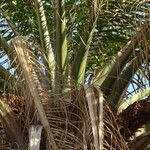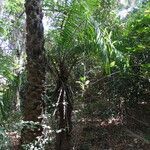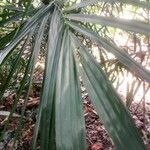Robust tree palm, in cultivated specimens often flowering while still trunkless.. Trunk to 30 m. tall, usually much less, 30–50 cm. diameter, rarely broader, covered by remains of leaf-bases when young, eventually becoming bare, but in high rainfall areas frequently obscured by epiphytes.. Crown massive, consisting of 40–50 expanded leaves in a 8/13 phyllotaxis. Leaves to 7.5 m. long in well-grown adults; leaf-base long-persistent, with coarse brown fibres and upward pointing fibre-spines to 35 × 5 mm., ± 10 mm. distant, confined to the sheath-margins; petiole to 1.25 m. long, to 20 cm. wide at the base, distally armed with bulbous-based spines to 4 cm. long by 1 cm. wide at the base, 1–5 cm. distant, representing pulvini and midribs of the basal-most leaflets; rachis semicircular in cross-section proximally, tapering above, with 2 lateral grooves or faces; leaflets eventually 100–150 on each side, inserted rather irregularly in 2 planes, the whole leaf hence plumose, to 120 cm. long, 8 cm. wide (in var. idolatrica A. Chev., a rare mutant, the lamina remaining ± entire, not splitting into leaflets).. Inflorescences either male or female, or rarely bearing both male and female, or even more rarely with hermaphrodite flowers, individual palms passing through alternating phases of male and female inflorescence production.. Peduncle of male inflorescence 15–20 cm. long, 5 cm. or more in diameter, densely hairy; rachillae crowded, ± 50 in number, 10–20 cm. long, 1–2 cm. wide, with a bare spine-like tip to 1 cm. long; bracts to 3 × 1.5 mm.. Male flower with 3 chaffy cucullate sepals to 2 × 1.5 mm., and 3 chaffy acute petals to 2 × 1.5 mm.; androecial tube to 2.5 mm. long at anthesis; anthers reflexed, to 1.5 mm. long.. Female inflorescence more massive than the male; rachillae much shorter, the spine-like tip to 2 cm. long.. Female flower accompanied by 2 usually abortive male flowers and 2 bracteoles; sepals ±10× 4 mm. with rounded tips; petals similar to sepals; staminodal ring to 1 mm. high, 6-toothed; ovary ± 5 mm. in diameter; styles and stigmas to 10 mm. long.. Fruit partially enclosed in the enlarged calyx and corolla, tipped by stylar remains, very variable in size, ± 3–5.5 × 2–3 cm., somewhat asymmetrical, usually bright orange with dark red, almost black pigmentation in the exposed upper parts; mesocarp ± 5–10 mm. thick, yellowish, oil-rich; endocarp blackish brown, 2–5 mm. thick.. Seed usually 1 only, 2–3 × 1–1.5 cm. with a thin integument; endosperm homogeneous with a narrow central cavity, oil-rich.. Figs. 10 and 11.
More
An unbranched palm with a stout erect stem. The stem is rough due to the leaf bases which remain attached. It grows to 20-30 m tall. The trunk is about 75 cm across. The crown consists of about 40 open leaves. These hang downwards. The leaves develop from the bud as a tightly rolled shoot which later opens. The palm crown spreads 5-9 m across. Casual roots grow from the lower 1 m of the base of the trunk. Many roots also grow just under the soil and spread out for 20 m around the palm. The leaves are about 7.5 m long. The leaves have spines along the leaf stalk. These leaves are made up of many leaflets (100-160 pairs). These are slender, long and thin and rich green. These are held at different levels along the midrib (Almost two rows). The flowers are of one sex only. The male flowers occur with a spiny tip. The female flowers are on long stalks. They are 30-45 cm long. The fruit is a large round bunch of small fruits. These are 4 cm long by 2 cm across. There can be 200 fruit in a bunch.
Leaves up to 8 m; segments ca. 120 cm. Fruits ca. 4 cm; ripening from green to yellow to red or black, 4 cm; endocarp black, 3-sided, bearing 3 germination pores. 2n = 32.
Several forms, differing in structure and colour of the fruit, are described in Kew Bull. 1909: 33 and 1914: 285, and in Holland 4: 734.
Easily recognizable by its arching, dark-green leaves and straight trunk clothed when young with petiole-bases
A tropical plant. They need a temperature above 18°C. They suit the hot humid tropics. They grow between 16°N and 15°S in Africa. These palms do well in rich moist soil. A rainfall above 2,000 mm is needed for good production. They need a sunny position. They are drought and frost tender. It grows from sea level to 900 m above sea level. It grows in areas with a mean annual temperature between 27-35°C. It grows in areas with a mean annual rainfall between 2,000-3,000 mm. Plantations are established in West New Britain in Papua New Guinea and palms occur in some other areas of the country. In Cairns Botanical Gardens. It suits hardiness zones 10-12. In Yunnan.
More
Is cultivated and occurs spontaneously in much of the forest zone from Senegal to Cameroun, being particularly abundant near habitations, in land which has been tilled, and in river valleys.
More or less open forest in moist, sandy soils that are often poorly drained. Often found along the edges of rivers.




